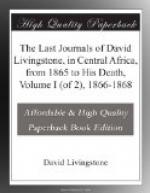It is tiresome beyond measure to wait so long, but I hope to see Moero for this exercise of patience, and I could not have visited it had Hamees not succeeded in making peace.
17th July, 1867.—A lion roared very angrily at the village last night, he was probably following the buffaloes that sometimes come here to drink at night: they are all very shy, and so is all the game, from fear of arrows.
A curious disease has attacked my left eyelid and surrounding parts: a slight degree of itchiness is followed by great swelling of the part. It must be a sort of lichen; exposure to the sun seems to cure it, and this leads me to take long walks therein. This is about 30 deg. 19’ E. long.; lat. 8 deg. 57’ 55” S.
24th July, 1867.—A fire broke out at 4 A.M., and there being no wind the straw roofs were cleared off in front of it on our side of the village. The granaries were easily unroofed, as the roof is not attached to the walls, and the Arabs tried to clear a space on their side, but were unable, and then moved all their ivory and goods outside the stockade; their side of the village was all consumed, and three goats perished in the flames.
Chitimba has left us from a fear of his life, he says; it is probable that he means this flight to be used as an excuse to Nsama after we are gone. “And I, too, was obliged to flee from my village to save my life! What could I do?” This is to be his argument, I suspect.
A good many slaves came from the two villages that were destroyed: on inquiry I was told that these would be returned when Nsama gave the ivory promised.
When Nsama was told that an Englishman wished to go past him to Moero, he replied, “Bring him, and I shall send men to take him thither.”
Hamees is building a “tembe,” or house, with a flat roof, and walls plastered over with mud, to keep his ivory from fire while he is absent. We expect that Nsama will send for us a few days after the 2nd August, when the new moon appears; if they do not come soon Hamees will send men to Nsama without waiting for his messengers.
28th July, 1867.—Prayers, with the Litany.[55] Slavery is a great evil wherever I have seen it. A poor old woman and child are among the captives, the boy about three years old seems a mother’s pet. His feet are sore from walking in the sun. He was offered for two fathoms, and his mother for one fathom; he understood it all, and cried bitterly, clinging to his mother. She had, of course, no power to help him; they were separated at Karungu afterwards.
[The above is an episode of every-day occurrence in the wake of the slave-dealer. “Two fathoms,” mentioned as the price of the boy’s life—the more valuable of the two, means four yards of unbleached calico, which is a universal article of barter throughout the greater part of Africa: the mother was bought for two yards. The reader must not think that there are no lower prices; in the famines which succeed the slave-dealer’s raids, boys and girls are at times to be purchased by the dealer for a few handfuls of maize.]




